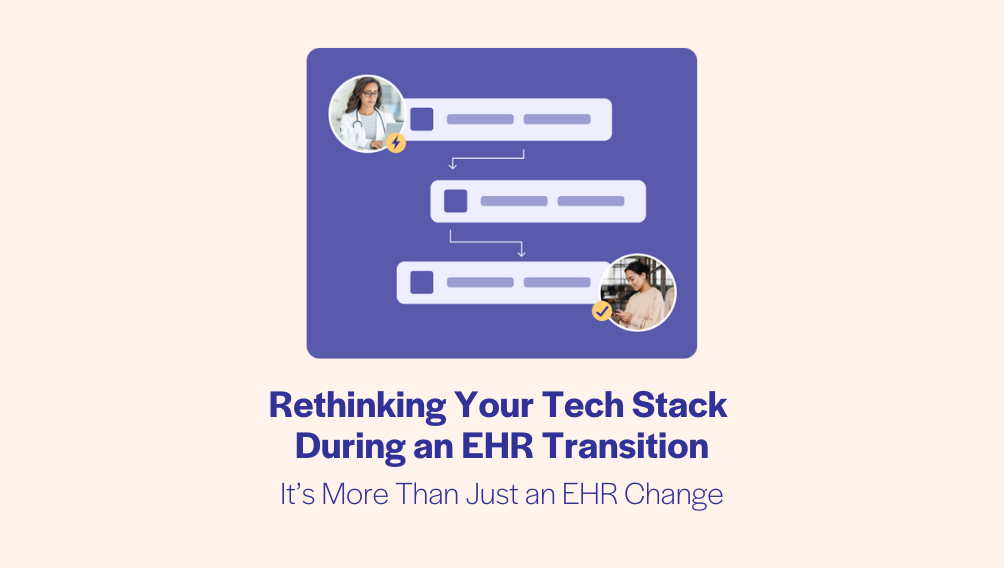Rethinking Your Tech Stack During an EHR Transition: It’s More Than Just an EHR Change

Changing your electronic health record (EHR) system is one of the most significant technology decisions a healthcare organization can make. But while most teams are laser-focused on the EHR transition itself, they may miss a critical opportunity: reevaluating their broader tech stack.
At Luma, we’ve seen firsthand how organizations like University Hospitals took a comprehensive approach to their EHR migration. Stacy Porter, who previously served as the VP of Digital Transformation at University Hospitals in Cleveland, says: “When you’re implementing a new EHR, it’s not just an opportunity — it’s an obligation to look at your entire digital portfolio.”
Here’s why evaluating your IT landscape during an EHR transition can unlock long-term value and how Luma can be an invaluable partner in the process.
1. Consolidate and Simplify Your Digital Portfolio
An EHR change often reveals redundancies and inefficiencies. Before University Hospitals switched to Epic, according to Porter, they completed a capability mapping exercise to compare their existing digital tools — including platforms like Salesforce, Conversa, and RevSpring — against Epic’s capabilities. This allowed them to make informed decisions about what to keep, what to replace, and where gaps existed.
Rather than defaulting to piecemeal solutions like Twilio for patient reminder texts, Porter asked: “Is there a vendor that can consolidate these functions and provide additional value?” Enter Luma Health. By selecting a partner like Luma, they reduced their vendor sprawl and ensured seamless interoperability with Epic from day one.
“When you’re implementing a new EHR, it’s not just an opportunity — it’s an obligation to look at your entire digital portfolio.”
Stacy Porter, former VP of Digital Transformation at University Hospitals
2. Co-Design for Long-Term Success
When evaluating vendors during an EHR transition, consider how co-designing can prevent future headaches. Porter emphasized this strategic approach: “We co-designed with Luma, so when we turned on both Epic and Luma, everything worked by design — no overlap, no retrofit.”
By collaborating with Luma early in the process, University Hospitals avoided unnecessary IT buildout later. This streamlined implementation and reduced the burden on their IT team, with Luma handling most configurations and only needing operational input.
3. Minimize Change Fatigue
For both patients and staff, transitioning to a new EHR means significant change. University Hospitals took a “rip off the Band-Aid” approach to minimize disruption. “Change once, change deep,” Porter said. Rather than subjecting patients and staff to waves of adjustments, they implemented Epic and Luma Health simultaneously.
This reduced the need for multiple rounds of training and communications, ultimately leading to smoother adoption and fewer frustrations.
4. Communicate Effectively
One of the most critical factors in a successful transition is proactive communication. Porter highlighted the importance of clear, consistent messaging to both patients, staff, and providers about what’s changing and why. Now imagine repeating that process three, six, or nine months later when introducing another solution — it’s a scenario best avoided.
By implementing Luma alongside Epic, University Hospitals ensured that everyone was aligned and informed upfront, reducing confusion and frustration.
5. Choose the Right Partners
Not all vendors are equipped to navigate the complexities of an EHR transition. Aditya Bansod, Luma’s co-founder, advises organizations to think holistically: “Every EHR conversation is part of a larger IT conversation. Use this as a moment to clean up your tech stack. Luma can be part of that.”
By choosing a partner like Luma, healthcare organizations can consolidate disparate tools, bring legacy systems into the future, and maximize their EHR investment.
EHR conversions take a lot of consideration from all fronts, and these five reasons make it clear: an EHR migration isn’t just a system switch — it’s a strategic opportunity to modernize and streamline your entire digital infrastructure. Here’s a quick recap to guide your planning:
- Consolidate and simplify: identify and eliminate redundant tools by mapping capabilities across your digital ecosystem, ensuring a streamlined, interoperable solution.
- Co-design for success: collaborate with key vendors early to reduce future IT burden and ensure seamless integration from day one.
- Reduce change fatigue: limit disruption by aligning new systems — like your EHR and patient engagement platform — for a single, comprehensive rollout.
- Communicate clearly: avoid confusion by sharing consistent, upfront messaging with staff and patients during the transition.
- Pick the right partners: select vendors who understand the bigger picture and can help modernize your tech stack while maximizing your EHR investment.
An EHR migration is not just a software upgrade — it’s a pivotal moment to evaluate and optimize your entire digital strategy. With the right planning, stakeholder engagement, and vendor support, your organization can turn this period of change into a long-term advantage.
At Luma Health, we’re here to help you make the most of your EHR investment. Let’s reimagine what’s possible together.